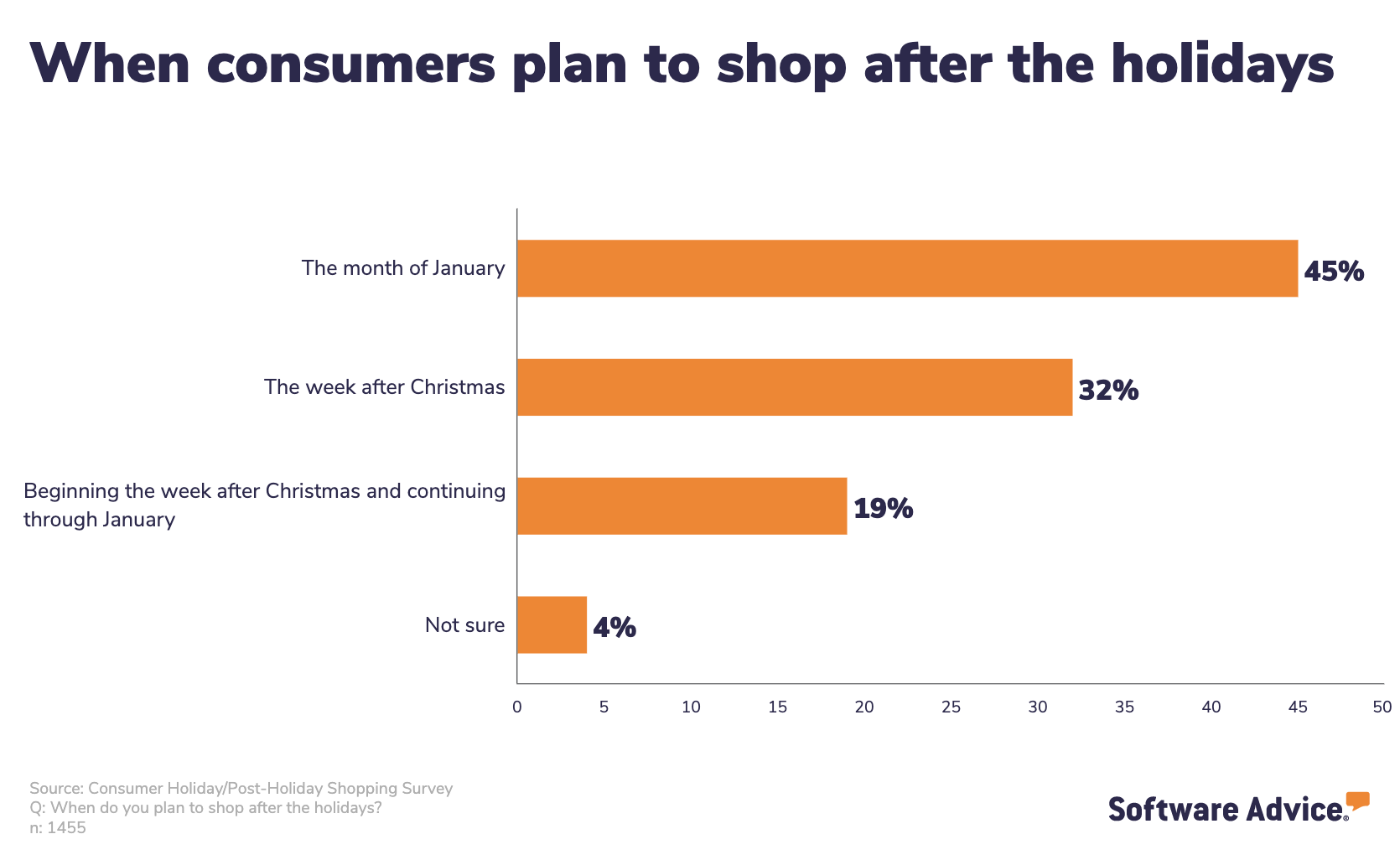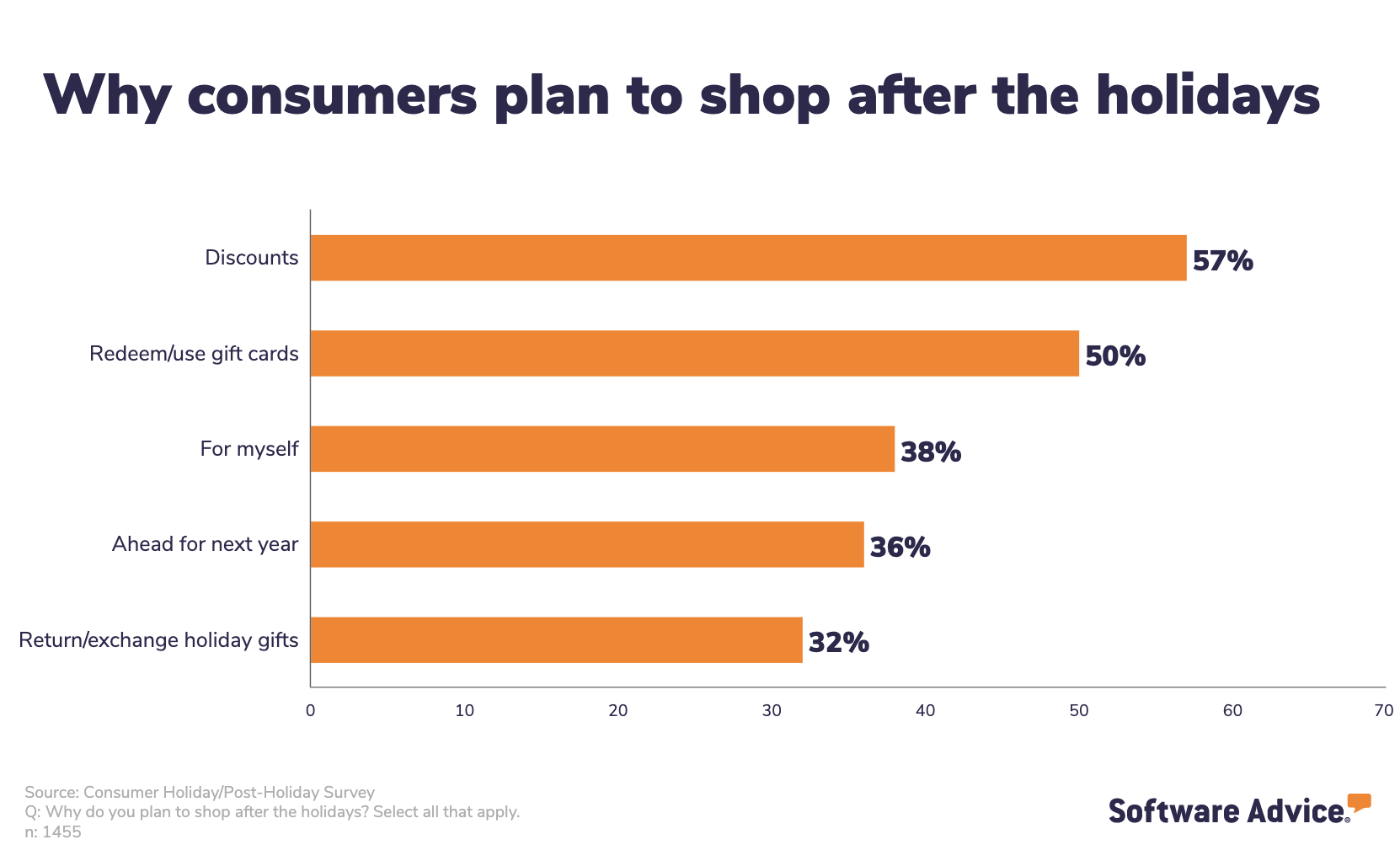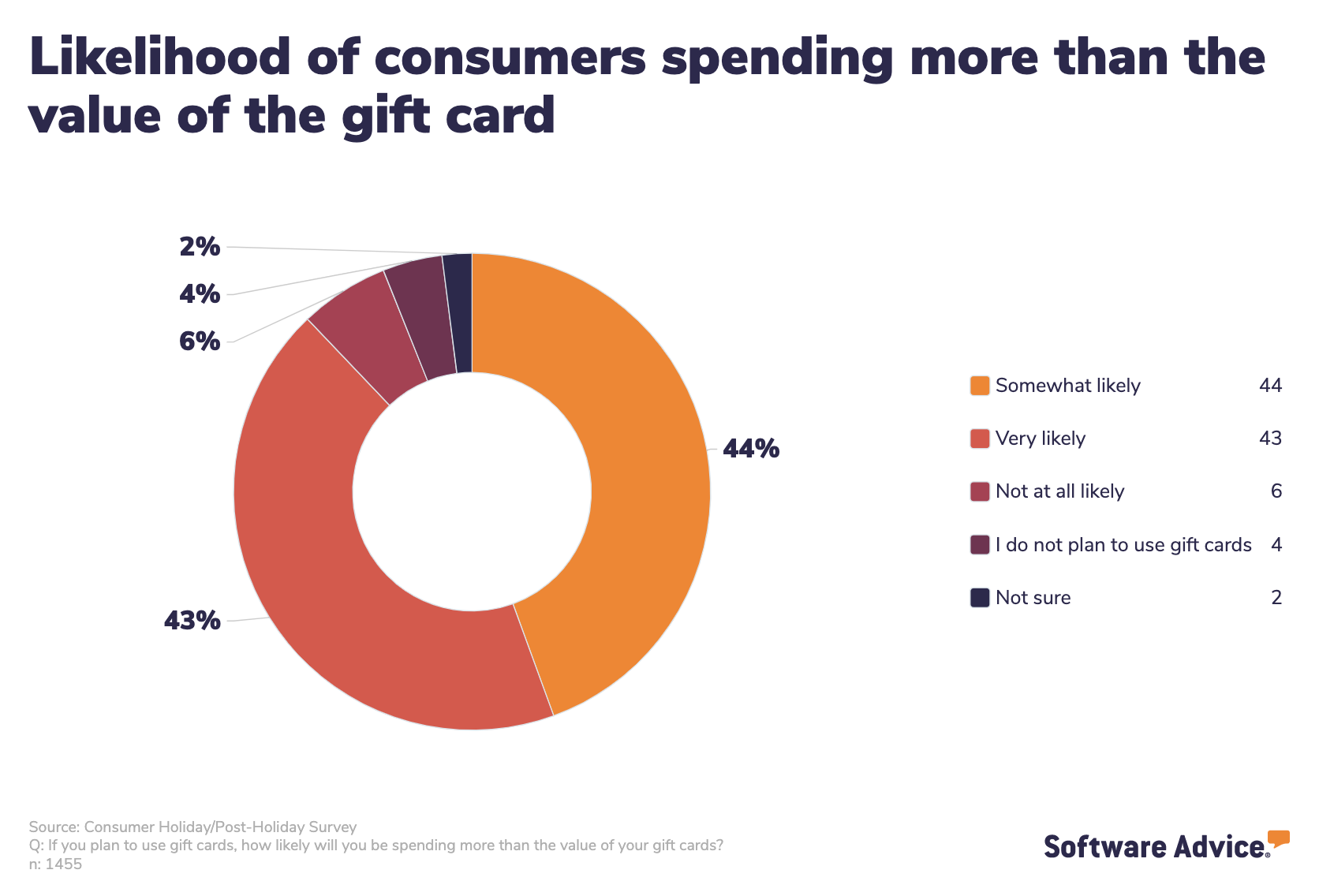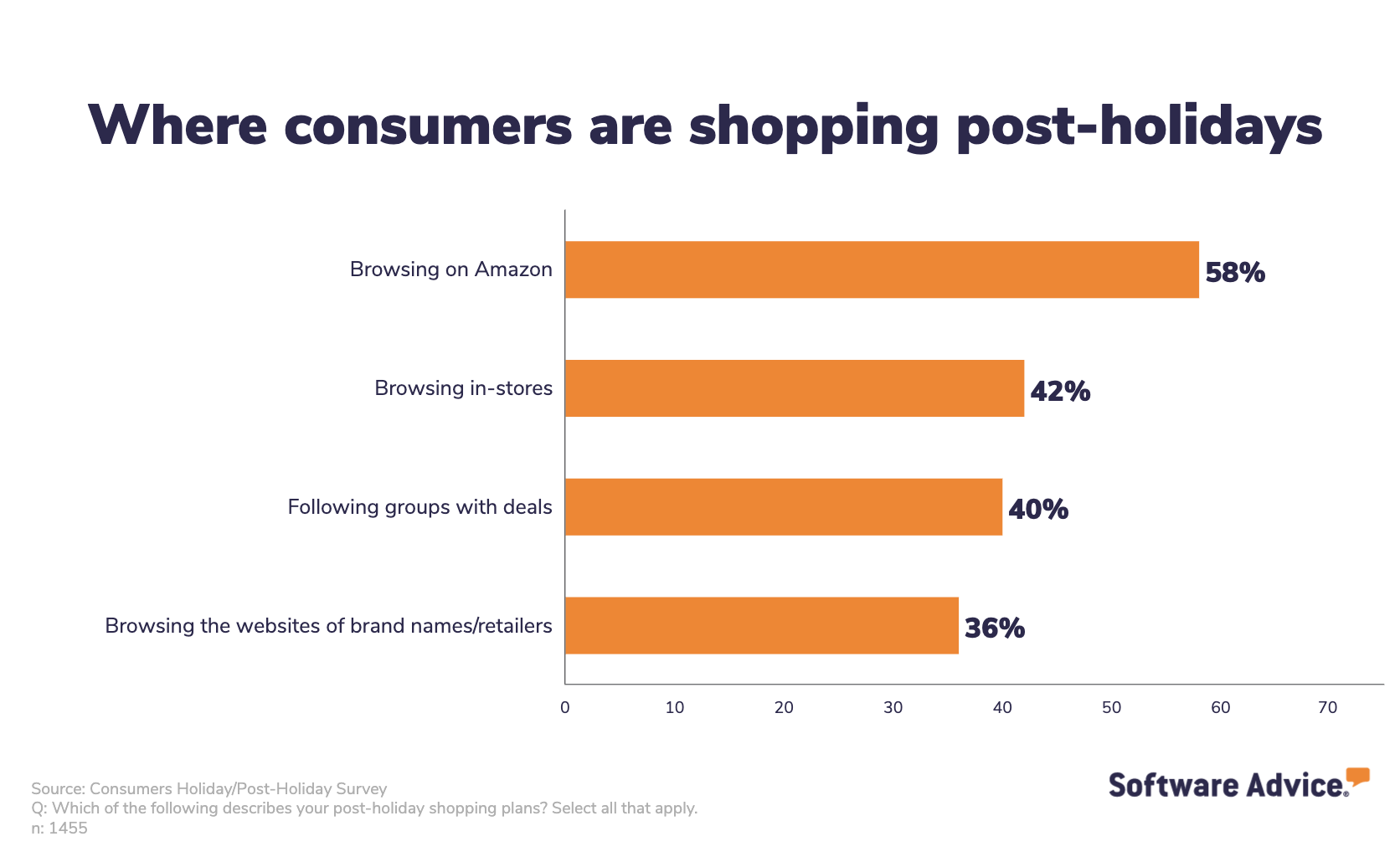Why Every Retailer Should Have a Post-Holiday Marketing Strategy
The holiday season has come and gone, but this year shoppers aren’t putting their wallets away just yet.
Software Advice surveyed over 1,400 consumers about their shopping behavior leading up to the 2021 holidays as well as their plans for early 2022. We found that 32% of consumers plan to shop the week after Christmas, and as much as 45% plan to shop in January.
In 2021, the shopping doesn’t end when Christmas sales are over. Shoppers are spreading their spending over more days as a result of supply chain worries (which appear to be sticking around for the foreseeable future). That’s why you need a post-holiday marketing strategy.
Without a post-holiday marketing strategy, your retail business could miss end-of-year targets and opportunities in the new year. A post-holiday marketing strategy can help retailers drive sales to finish this year and start the new one on a strong note.
In this report, we’ll share key insights from our consumer survey, paired with recommendations for how you as a retailer can take action and develop an effective post-holiday marketing strategy to meet the demands of shoppers continuing to purchase into and past the New Year.
Insight 1: Consumers are spreading out their shopping over a longer period, partly due to supply chain worries
According to our survey, 95% of consumers started shopping for the holiday season as early as October 2021. Many are extending their shopping period after the holiday, with 45% planning to shop in January 2022.

Why this matters for your post-holiday marketing strategy:
Online sales for Black Friday and Cyber Monday declined for the first time in 2021.
Given widespread supply chain delays, early deals in October, and retailers encouraging advance shopping for the 2021 holidays, shoppers weren’t waiting around for traditional big shopping days. Consumers are spreading out their shopping before, during, and after the holidays.
That’s good news for retailers looking to drive more sales after the holidays. More than ever, a post-holiday marketing strategy is a must in every retailer’s toolkit.
How to implement as part of your post-holiday marketing strategy:
Start building yours by analyzing your customer data for the previous year’s holiday shopping season (as well as past years if you have access to that data).
Ask and answer a few questions, such as: which marketing channels yielded the most sales during the same period last year? Which products were bestsellers during that time? What emails had the most conversions? Tap into that insight to help inform your post-holiday marketing strategy.
Insight 2: Consumers are ready to spend on themselves after the holidays
The end of the holidays doesn’t signal the end of shopping. What keeps shoppers engaged? Most are enticed by great discounts and deals.
When we asked consumers why they’re planning on shopping after the holidays, 57% cited anticipated discounts, 50% plan to use gift cards, and 38% of respondents said they’ll be shopping for themselves.

Why this matters for your post-holiday marketing strategy:
Returning to full price once the holidays are over is a missed opportunity, especially when consumers are still open to a good bargain after the holiday rush.
How to implement as part of your post-holiday marketing strategy:
Where possible, try to stay consistent in your post-holiday strategy. Launch your promotions and offers around the same time so customers know when to expect them.
Next, you’ll want to calculate how large of a discount you can afford. There are ways to offer smart discounts and promotions without killing your profit margin while driving profitability.
One example is a classic buy one, get one free deal. Volume-based discounts incentivize customers to purchase more products in order to get a discount and can help you move specific inventory that you may be struggling to sell.
Insight 3: Gift cards aren’t going away
As consumers navigate shipping delays and potential out-of-stock issues, the ease of giving a gift card has been more apparent than ever in the 2021 holiday shopping season.
Consumers are spending more on gift cards and buying them earlier than they did in 2020, with digital gift cards accounting for nearly 30% of gift cards purchases, up from 20% the previous year.
According to our survey, 50% of consumers plan to use gift cards to shop after the holidays, with an overwhelming 87% saying they are somewhat and very likely to spend more than the value of their gift cards.
Just how much more are consumers planning to spend on top of their gift cards? About one in five say $41-50, while nearly one in seven say $51-60.

Why this matters for your post-holiday marketing strategy:
Gift cards remain a popular choice among shoppers and retailers.
This option gives retailers the ability to extend the holiday season and produce a revenue stream into 2022 as shoppers postpone purchases due to supply chain delays or take advantage of post-holiday discounts.
In addition to standard purchases of gift cards that customers give as gifts, you can run a gift card promotion where customers themselves receive a gift card if they spend a certain amount (e.g., they receive a $5 store credit/gift card for every $50 worth of gift cards purchased).
How to implement as part of your post-holiday marketing strategy:
Here are some tips on how to implement a successful gift card program:
First, create a marketing campaign to spread the word to your customers. Ensure your gift card promotion is advertised prominently across all marketing channels (such as social media and email).
Communicate policies and the terms and conditions of your gift card promotion to make sure everyone is clear on the duration and redemption parameters.
Set goals and track performance. Possible metrics include number of gift cards sold, revenue generated, and ratio of purchases to redemption.
Have a specific call-to-action after the holidays. To produce a faster and more effective revenue stream after the holiday season, your call-to-action should drive redemption during a specific period after the holidays or in the new year. Providing a compelling gift card promotion will incentivize and motivate return shoppers to make a purchase during a set period, providing a steady revenue stream for your business.

An example of a gift card promotion from DSW (Source)
Insight 4: Consumers are shopping on Amazon (and your competitors are selling on Amazon)
One in three consumers will be browsing on Amazon as part of their post-holiday shopping plans, according to our survey. If shoppers aren’t buying from you, then they’re purchasing from your competitors.

According to the ecommerce giant, independent third-party sellers (almost all of which are small and midsize businesses) increased their sales on the platform by more than 55% year-over-year.
Why this matters for your post-holiday marketing strategy:
Retailers should view the ecommerce giant as another online route to reaching their customers and driving sales, especially when many of their competitors are selling on the platform.
How to implement as part of your post-holiday marketing strategy:
If you decide to sell on Amazon, it’s important to optimize your listing on the platform. That includes:
Optimizing search terms and categories: This is a key factor for the visibility of your products in Amazon’s search results. Consider what your target shopper might look for, and work on a combination of search terms to include your product in their results.
Optimizing product descriptions and images: Take the time to submit a detailed product description alongside a high-quality product picture.
Asked about their post-holiday shopping plans, 35% of consumers say they plan to browse online groups with deals, followed by emails, and the websites of brand names and big box retailers.
Even if you don’t decide to sell on Amazon, consider other online channels such as email or social media ads to reach new customers that you wouldn’t have accessed in the past.
Prepare for your post-holiday marketing strategy now
It’s tempting to relax and take a back seat at the end of the year after you’ve invested so much in your holiday marketing campaigns. But to do so would be a missed opportunity.
A post-holiday marketing campaign is just as important as a holiday marketing campaign when it comes to achieving your year-end targets and goals, as well as setting your business up for success in the new year.
For more help with your marketing efforts and strategy, check out these resources:
When To Prepare and Launch Retail Holiday Marketing, Plus Other Strategies
3 Proven Ways to Drive Gift Card Sales and Increase Your Profit
Survey methodology
*The Software Advice Post Holiday Marketing Survey was conducted in October 2021. We collected 1,455 responses from the general U.S. population who had plans to shop after the holidays. The goal of this survey was to learn consumer behavior and sentiment about how they plan to shop after the holidays.